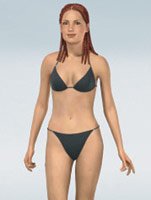Apparel Firms Use Oscar-Winning Technology in Design, Merchandising
With a bit of Hollywood magic and the latest advances in 3D graphics technology, apparel companies are ready to take garment design and visual merchandising to the next level.
Cutting-edge 3D software, provided by companies such as Toronto-based Alias/Wavefront, is making it all possible. CAD/CAM developer PAD System Technologies and visual- merchandising firms Toyobo and My Virtual Model are among those using Alias/Wavefront’s Maya 3D graphics software to enhance their product offerings.
Maya is the same graphics software that movie studios are using to produce special effects and animation in films such as “Spider-Man” and “Star Wars II: Attack of the Clones.” The software, which has become the industry standard, won an Oscar during the Academy of Motion Picture Arts and Sciences’ Scientific and Technical Awards, held March 1 at the Regent Beverly Wilshire hotel. Alias/Wavefront’s Doug Walker and Kevin Tureski received the award, and a recording of their acceptance was broadcast during the main Academy Awards show.
Other 3D technology has enhanced merchandising and design for a number of technology providers, including Lectra and Tukatech. Now companies such as PAD, My Virtual Model and Toyobo are using Maya to take apparel Web sites and pattern-making to the next level.
Using Maya, online operations for retailers such as Lands’ End, HSN, Kenneth Cole, Orvis and Lane Bryant can now offer customers the option to create a model of themselves based on weight, hair color and body type and enter a virtual dressing room where they can “try on” selected clothing items. With the click of a mouse, users can rotate models 360 degrees to get a full perspective of how garments look and fit.
The same goes for the patternmaking process. Users of PAD’s Haute Couture 3D can drape a 3D model and see how their patterns appear in motion.
“It definitely helps the patternmaker visualize the garment much better, and that’s important,” said PAD’s Julie Lefebvre. “Previously, it would be a static image with a model with the arms out and feet spread apart. It comes to life now.”
Toyobo’s parent company, Japanese textile giant Toyobo Co. Ltd., in 2001 helped found Digital Fashion Ltd. and its dressingsim.com Web site, which helps apparel makers and others create 3D garments through its dressingSim PatternMaker for Maya. DressingSim also features a virtual fitting room and a data library of digital garments. Users can import pattern data from CAD systems into Maya or create garments and simulate fabric draping and garment movement on animated characters.
Conversely, animators and movie studios—including Pixar Studios, which produced “Toy Story” and “Monsters, Inc.” for Disney—have aligned with companies such as PAD to assist in the production process. PAD is helping Pixar create realistic digital apparel for its animated characters. Using PAD’s technology, Pixar can design 3D hats that flap in the wind and shirts that ruffle during movement.
Maya was created five years ago after Alias/Wavefront saw its predecessor; PowerAnimator—used in “Jurassic Park,” “The Abyss” and “Terminator 2: Judgement Day”—reach its technical limits.
Now, apparel makers see a new world of flexibility in the software. Lands’ End spokespeople said that its 3D models and virtual dressing rooms have resulted in 25 percent more purchases.























